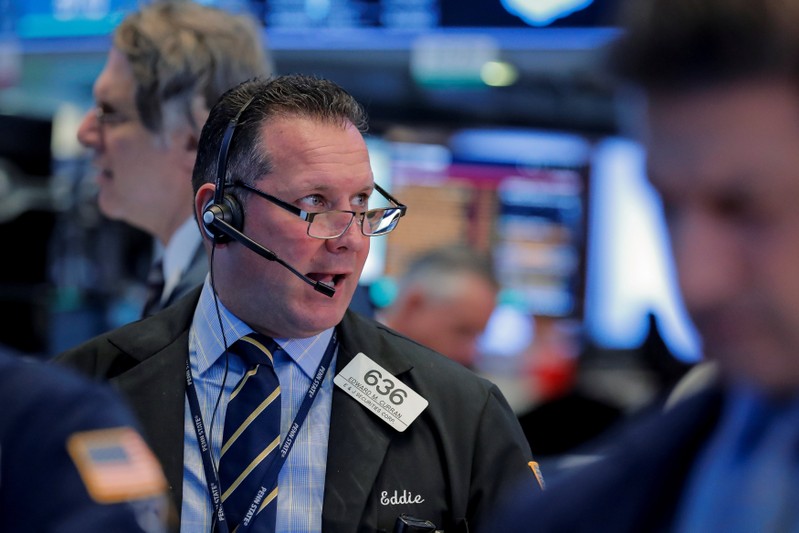
Traders work on the floor of the New York Stock Exchange (NYSE) in New York, U.S., August 23, 2018. REUTERS/Brendan McDermid
August 24, 2018
By Trevor Hunnicutt
NEW YORK (Reuters) – U.S. fund investors are in no rush to shore up defenses against the strong dollar.
The greenback’s 6 percent leap over the past six months has flummoxed markets from Turkey to Argentina, whose governments have to repay debt in dollars.
The stronger currency, which makes U.S. exports more expensive to foreign buyers, has also frustrated President Donald Trump, who is trying to reduce U.S. trade deficits.
Yet among the least popular exchange-traded funds (ETFs) this year are “currency hedged” funds, which invest in stocks abroad but strip out the effect of a foreign currency’s performance using derivatives. That makes the funds more resilient in a “King Dollar” world, when the greenback is dominant, which hurts U.S. investors converting foreign stock gains back into dollars.
Some investors are betting that the dollar’s run has gone too far given the risk of seismic U.S. congressional elections in November or the potential for the U.S. Federal Reserve to slow down the pace of interest rate hikes.
“We’re not really hedged right now even though the consensus is for a strong dollar,” said Komson Silapachai, vice president of research and portfolio strategy at Sage Advisory Services Ltd. “We think there’s a bigger chance that the market is underpricing the chance for a weaker dollar.”
U.S.-based currency-hedged funds have logged $10.2 billion in withdrawals this year, while their unhedged counterparts have attracted $30.7 billion, according to FactSet Research Systems Inc. That is a break from past practice, when investors rewarded currency-hedged funds as the dollar gained.
Hedged funds took in $51.9 billion in 2014 and 2015 as the dollar leapt by more than a fifth, FactSet data shows. Currency-hedged ETFs nearly tripled in number from 20 to 58 from 2014 to 2016 in the United States. The figure has not grown since 2017.
In the more than eight months of the year-so-far, the dollar has depreciated about 2 percent against the yen <JPY=> but gained more than 3 percent against both the euro <EUR=> and a basket of top trading partners’ currencies <.DXY>.
The euro’s decline helped the WisdomTree Europe Hedged Equity Fund <HEDJ.P>, up 5.2 percent this year, significantly outperform the nearly flat 0.4 percent return of the unhedged Vanguard FTSE Europe ETF <VGK.P>, according to Thomson Reuters’ Lipper research unit.
Nonetheless, the hedged WisdomTree Europe fund hemorrhaged $2.2 billion because of withdrawals this year, far higher than the $755 million investors pulled from the unhedged Vanguard Group Inc product, Lipper said.
Fast-trading investors are playing a risky game.
Morningstar Inc analyst Daniel Sotiroff studied the performance of the currency-hedged funds from 2010 to 2018 and found investors typically underperformed the market by attempting to time the currency market.
Still, the dollar tends to falter later in the year, especially ahead of U.S. midterm elections, Silapachai said. The November elections could hand control of the U.S. Senate or House of Representatives to Democrats, who are currently in the minority, opinion polls show.
The dollar could also falter if rates do not keep rising.
Rising rates attract yield-hunting foreign investors, but the Fed could delay hikes if inflation stays tame or the economy deteriorates. Short-term rates controlled by the Fed are getting closer to topping long-term rates set by the market, an omen for recession.
RiverFront Investment Group LLC, which along with Sage is among the biggest ETF investment advisers, is no longer using currency-hedged ETFs, according to its chairman, Michael Jones. He said Trump might resolve trade rifts in Europe and North America, giving a boost to foreign currencies, such as the euro.
“We believe that Trump really wants to resolve the trade conflict with the EU and NAFTA before the midterm elections,” said Jones. The United States, Mexico and Canada have been renegotiating the 24-year-old North American Free Trade Agreement.
Even investors prepared for an end to the dollar rally disagree on whether emerging markets have bottomed. Either way, the result could be a weaker dollar.
If the Fed holds off on hiking rates because of a brewing emerging market crisis, the greenback could falter. Conversely, if emerging markets rebound, U.S. investors could sell dollars to buy foreign stocks.
Jeremy Schwartz, WisdomTree Investments Inc’s <WETF.O> director of research, warned that investors have significant assets in funds with dollar exposure, including domestic multinational companies that will find it harder to export their goods as the dollar rises.
Schwartz said his company’s models are more hedged than usual on both developed and emerging markets, meaning they are on guard for further declines against the dollar.
Yet, he said, investors “largely have defaulted to the status quo.”
(Reporting by Trevor Hunnicutt; Editing by Jennifer Ablan and Leslie Adler)
